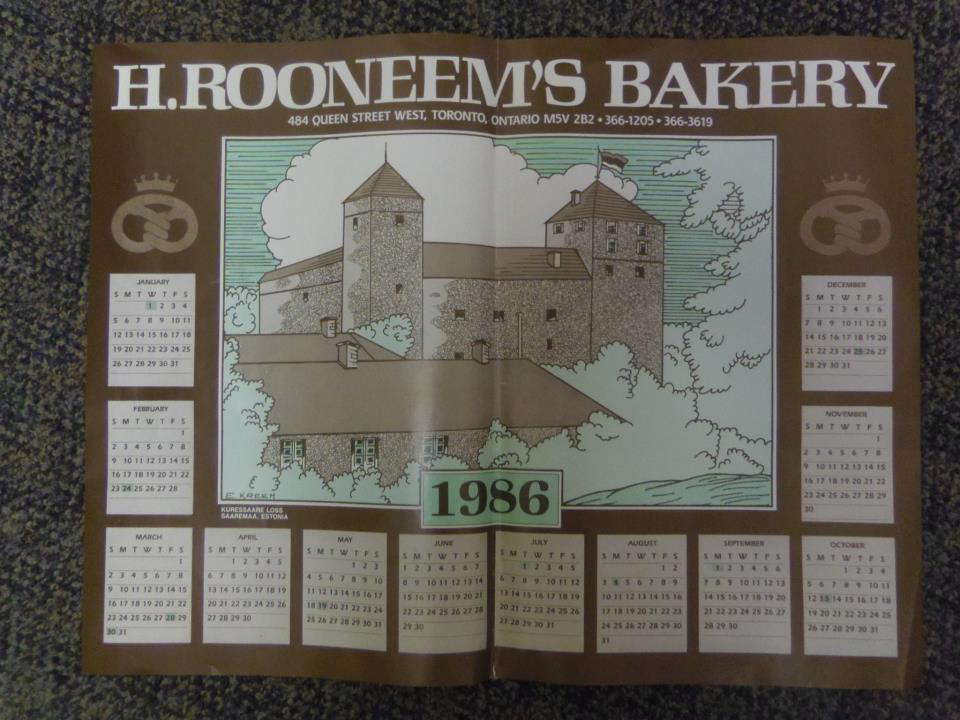Preserving our History
2013 is the year of cultural heritage in Estonia. The goal of this year’s theme is to promote cultural issues to the general public – to recognize that culture concerns, in one way or another affects each of us, and that it is worthy of appreciation and preservation. Throughout the year of cultural heritage many events will take place to explain what cultural heritage is, introduce its importance and, broaden its understanding. You can read more about the year of cultural heritage at: www.parandiaasta.ee.
In honour of the year of cultural heritage, VEMU/The Estonian Studies Centre is organizing the archival contest “Preserving our history.” In keeping with the motto “No heritage without heir,” we are looking for contributions from Canadian Estonians, but in particular from children and young people, as they inherit Estonian culture from the previous generation.
The contest aims to consider the daily lives of Canadian Estonians over the decades, like food and daily chores, Estonian grocery stores in Canada. Estonian culture is not only preserved in fighting for Estonian freedom, singing and dancing, reading Estonian literature, and teaching children the Estonian language. Culture grows while eating sauerkraut and blood sausage, baking kringel and pirukad, and decorating your home with Estonian handicrafts. It grows while following and understanding the culinary traditions and consumer culture of our homeland.
WHAT TO REASEARCH:
FOOD
Describe you family’s food habits over the decades. What is a typical family meal today? Where did your family buy their food in the past and where do they buy it now? Do you have any family traditions associated with food? What were/are typical festive meals? What are the traditions associated with them? Have they changed? Does your family have different dishes, pots, pans, ladles, and cutlery that are associated with your family’s history? Write these down! What recipes or cookbooks have been used? Does you family follow any customs associated with food? (e.g. kissing your bread, don’t talk with your mouth full, don’t waste food, and so on)?
HOUSE & HOME
What was your family’s living conditions in Estonia, in displaced persons camps, their new life in Sweden, Germany, and Canada? How were/are these places furnished? Where did they buy their furnishings? Describe the home and garden. How did daily life, practices and habits change? How are daily chores divided? Is there a difference between men and women’s work? When were household chores performed? Why? What rules have been established in your home (e.g. taking your shoes off at the door, no whistling inside)? Are any special days celebrated in your home? How?
ESTONIAN GROCERY STORES
Which Canadian Estonian restaurants or cafés have your family members visited? Describe changes in restaurant and café culture over the years. Which Estonian grocery stores do/have you shop/ shopped at? Where was the grocery store? When was it in business? Describe the neighbourhood in which the store was situated. What is there now? Who were/are the owners? Describe them. Describe what the store sold and how that has changed over time: its size, rooms and merchandise, what, how and who was it marketed to, who were the clients, who were the employees/partners. Think of some colourful stories. Apart from Estonian grocery stores, where have you bought Estonian food? What other cuisines does your family enjoy? Why?
HOW TO RESEARCH
Entries can be submitted as written pieces (in Estonian or English), audio or film. You can also create a website/virtual exhibit, or how about a documentary film. Parents and grandparents can write down their memories. Younger persons could interview their family members (mother, father, grandmother, grandfather, aunt, uncle, sister, brother), and transcribe the interviews, or record them as audio or film files. Be sure to look through your family photo albums. Many times you will find pictures of the places mentioned above. Describe the photos; write down stories that go together with the photographs. Analyze the photographs: what does the photo say about its time, what is no longer there today, what has changed, what remains. Compare photographs of the same location taken at different times. Look at your family archives. Often you can find memories, journals, letters, handwritten recipe books, household management books and so on. Maybe you have something at home that is tied to this theme: cookery books, household management and design books, café menus, grocery stores advertisements, receipts, newspaper/magazine clippings etc. You can copy these materials, digitize them and add them to your research. We are looking for original archival materials in particular, like photos, recordings, films, printed materials, and other similar things.
Collected materials will be preserved at VEMU and will be used in an upcoming VEMU exhibit.
The deadline is November 1, 2013. Please send entries to:
VEMU/Estonian Studies Centre
310 Bloor Street West
Toronto, ON
M5S 1W4
To keep all entries anonymous we ask that you choose a keyword by which to name your entry, for example “Home.” Do not put your name on your entry, but rather your keyword. Include a separate envelope labelled with your keyword and inside please include the following information: name, age, address, telephone number, and email.
Winning entries will be announced November 17, 2013. Cash and book prizes will be awarded to the best entries!
Kristina Lupp
